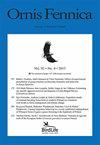Chick survival in a high-density Northern Lapwing (Vanellus vanellus) population on the river islets of the middle Pripyat River, Belarus
IF 1.2
4区 生物学
Q2 ORNITHOLOGY
引用次数: 0
Abstract
The field studies were conducted in three ephemeral river islets of the middle Pripyat River, southern Belarus in 2006–2007. Nestlings of the Northern Lapwing (Vanellus vanellus) were ringed soon after hatching, and reencountered during subsequent visits. Post-hatching survival was estimated by capture-mark-recapture models. Daily survival rates of the Northern Lapwing chicks were very high, varying between 0.90 and 0.99, and the cumulative survival rates over 35 days between hatching and fledging were 0.54 and 0.70 in 2006 and 2007, respectively. Survival rate was lower in the first ten days of life, which is similar to that reported in other precocial species. The key factor supporting this high breeding success is low predation due to nesting of lapwings on periodic river islets that naturally restrict access by mammalian predators and apparent scarcity of terrestrial and avian predators. River islet habitats with co-occurrence of dry and wet fertile microhabitats provide optimum feeding conditions for the Lapwing chicks with a wide range of aquatic, ground and surface invertebrates. Moreover, semicolonial breeding of the Northern Lapwing (about 30 nests/ha) with other waders, terns and gulls increases the effectiveness of anti-predator behaviour. Consequently as a result of low predation pressure and good foraging conditions, in 2006 and 2007, productivity was 2.1 and 2.8 fledged young per single nest with four chicks respectively, a value hardly reported in Europe, except in managed sites.白俄罗斯普里皮亚季河中游小岛上高密度北拉普兰(Vanellus Vanellus)种群中的鸡生存
2006年至2007年,在白俄罗斯南部普里皮亚季河中部的三个短暂河流小岛进行了实地研究。北斑蝶(Vanellus Vanellus)的雏鸟在孵化后不久就被环住了,并在随后的访问中再次受到攻击。孵化后的存活率是通过捕获标记再捕获模型来估计的。2006年和2007年,北拉普兰雏鸟的日存活率非常高,在0.90和0.99之间变化,孵化和孵化之间35天的累计存活率分别为0.54和0.70。在生命的头十天,存活率较低,这与其他早熟物种的报告相似。支持这种高繁殖成功的关键因素是低捕食性,因为垂翼鸟在周期性的河流小岛上筑巢,自然限制了哺乳动物捕食者的进入,陆地和鸟类捕食者明显稀少。河流小岛栖息地同时存在干燥和潮湿肥沃的微栖息地,为拥有各种水生、地面和地表无脊椎动物的拉普兰幼鸟提供了最佳的喂养条件。此外,与其他涉禽、燕鸥和海鸥进行半殖民地繁殖(约30个巢穴/公顷)可以提高反捕食者行为的有效性。因此,由于捕食压力低和觅食条件好,2006年和2007年,每窝四只雏鸟的生产力分别为2.1和2.8只,这一数值在欧洲几乎没有报道,但在管理区除外。
本文章由计算机程序翻译,如有差异,请以英文原文为准。
求助全文
约1分钟内获得全文
求助全文
来源期刊

Ornis Fennica
生物-鸟类学
CiteScore
2.00
自引率
0.00%
发文量
14
审稿时长
>12 weeks
期刊介绍:
Ornis Fennica is a peer-reviewed international ornithological journal published by BirdLife Finland. Ornis Fennica publishes analytical and experimental papers on the ecology, behaviour and biogeography of birds. Ornis Fennica prefers studies concerning Fennoscandian species, but other novel contributions of general interest are most welcome as well.
Ornis Fennica is an open-access journal without page charges for publication. All published articles (from 1924 onwards) are freely available from the journal website. First decisions are usually made within three months of submission.
 求助内容:
求助内容: 应助结果提醒方式:
应助结果提醒方式:


